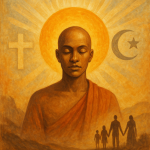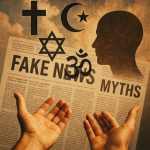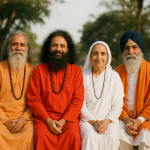Digital Faith Influencers: YouTube, Instagram & Spiritual Branding
The intersection of faith and the digital world has created a fascinating new space — one where spiritual teachings, personal enlightenment, and online branding coexist. Across India and beyond, a new generation of digital faith influencers has emerged on YouTube, Instagram, and other platforms. They are not just preachers or monks; they are storytellers, motivators, and content creators who use technology to spread ancient wisdom in modern language. This blending of spirituality and social media has reshaped how people seek, share, and experience faith.
The Rise of the Digital Guru
Gone are the days when religious discourse was confined to temples, mosques, and gurdwaras. Today, a smartphone screen can serve as a digital shrine. Platforms like YouTube and Instagram have become global pulpits for spiritual expression. Figures such as Sadhguru, Gaur Gopal Das, Sister Shivani, Ma Anand Sheela, and countless regional saints have transformed the online space into a spiritual classroom. They deliver teachings through short reels, podcasts, and live Q&A sessions — formats that fit seamlessly into the daily digital diet of millions.
This digital transformation is democratizing access to spirituality. A teenager in Delhi or a working professional in Dubai can now attend a virtual satsang or watch a motivational clip during a lunch break. Algorithms once designed to push entertainment now also amplify meditation, mindfulness, and moral reflection. The result is a spiritual marketplace that’s vibrant, personalized, and constantly evolving.
Faith Meets Branding
One of the most striking aspects of this phenomenon is spiritual branding. Faith influencers, like lifestyle or fitness creators, craft a digital identity built on authenticity, aesthetics, and relatability. Their Instagram pages are curated with serene visuals — mountains, lamps, smiles, and sacred texts — all carefully designed to communicate peace and purpose.
But beyond visuals, branding also lies in message consistency. A faith influencer’s “brand” might center on simplicity (as in minimalist monks), self-discipline (as with yoga teachers), or universal compassion (as in interfaith educators). The language is inclusive and motivational rather than doctrinal. This approach helps them reach audiences beyond traditional followers of a single religion.
Monetization is another layer of spiritual branding. Many digital gurus host paid webinars, mindfulness retreats, or merchandise lines featuring quotes and symbols. While this commercialization raises ethical questions, it also enables sustainability — allowing spiritual educators to remain independent of institutional funding. In essence, these influencers have professionalized spiritual service, turning it into a career that blends devotion with entrepreneurship.
Reaching the Digital Devotee
The new generation of digital devotees differs from their predecessors. They are tech-savvy, globally connected, and often skeptical of institutional religion. What they seek is not ritual authority but emotional clarity. Digital influencers address this demand by offering spirituality as a form of personal therapy — a way to manage stress, relationships, and mental health.
Platforms like YouTube allow long-form discourse, where teachers can unpack complex ideas from the Bhagavad Gita, Quran, or Bible in relatable language. Instagram, on the other hand, thrives on brevity — a 30-second reel on forgiveness, a quote on mindfulness, or a calming chant that instantly soothes. These micro-moments of spirituality help users integrate faith into their busy lives.
Interestingly, many influencers also use humor, storytelling, and pop culture references to make spiritual ideas accessible. A monk quoting a Bollywood film or a nun discussing Instagram addiction may sound unconventional, but this is exactly what makes their content shareable and relevant.
Challenges of the Digital Pulpit
However, the digitalization of faith also brings challenges. The pursuit of followers and engagement can sometimes overshadow the purity of spiritual intention. The line between spiritual leadership and celebrity culture blurs easily when metrics like likes and views become measures of influence.
There’s also the danger of oversimplification. Profound spiritual teachings risk being reduced to catchy slogans or viral soundbites. Moreover, misinformation can spread under the guise of “spiritual wisdom,” especially when unqualified individuals claim authority without proper grounding in religious study.
Another concern is performative spirituality — where authenticity gets lost in the aesthetics of online presentation. The risk of turning faith into a visual brand rather than an inner journey is real. Yet, many influencers are conscious of this tension and actively strive to maintain balance by emphasizing self-reflection, community service, and humility.
The Future of Digital Faith
The future of spiritual communication is undoubtedly digital — but not necessarily superficial. As artificial intelligence, virtual reality, and live streaming evolve, faith experiences will become more immersive. Imagine attending a 3D meditation guided by a virtual monk, or joining a global interfaith prayer circle in real time. These technologies can make spirituality even more inclusive and experiential.
At the same time, collaboration between faith influencers and psychologists, educators, and social reformers can expand the social impact of digital spirituality. The rise of “eco-spirituality,” “mindful entrepreneurship,” and “digital ethics” shows how online faith can contribute to real-world change. Digital faith influencers are reshaping the way spirituality is practiced, perceived, and promoted. They have turned YouTube channels into temples of learning and Instagram feeds into visual prayers. While their success brings challenges of authenticity and commercialization, it also represents a hopeful shift — where ancient wisdom finds new life in the language of the digital age.
In a world flooded with noise, these influencers offer moments of stillness. They remind us that even in the glare of screens, the search for light — the spiritual kind — continues to guide human hearts.
~Religion World Bureau








